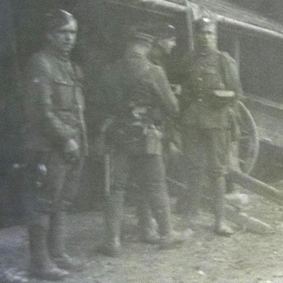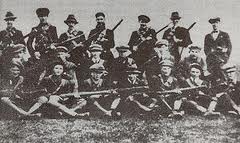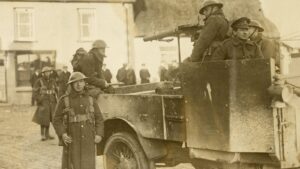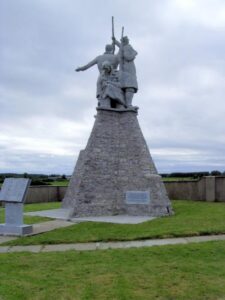Today in Irish History, 23 March 1921 – The Scramogue Ambush

By Thomas Tormey
On 23 March 1921, Spy Wednesday, a combined force of the North Roscommon and South Roscommon Brigades launched a successful ambush on a British military transport lorry, a Crossley tender, at Scramogue three miles outside Strokestown, on the eastern side.
This tarred road was a main arterial route between the north western portion of Connacht and British garrisons at Longford and further east.
The combined IRA force was essentially an ad hoc grouping of the more active elements of the 3rd Battalion of both brigades: the 3rd Battalion North’s flying column and the men of the Kilgefin company of the 3rd Battalion South.
On 23 March 1921, the North Roscommon and South Roscommon IRA Brigades launched a successful ambush on a British military transport lorry at Scramogue three miles outside Strokestown
The Strokestown-Longford road ran close to the brigade boundary and both in turn bisected the heartland of militant republicanism in Roscommon. Most of the IRA party had been born and raised within a few miles of the ambush site.[1]
The British force consisted of a party of Lancers, stationed at Strokestown House. This group of five Lancers, plus a Royal Army Service Corps member acting as a driver, were transporting three RIC constables to Longford as prisoners.[2] The Lancers were in one lorry that had a mounted machine gun. It seems, though it is by no means certain, that a second lorry of RIC/Black and Tans was supposed to accompany the army lorry as an escort, but fell behind.[3]
Planning the ambush

It is difficult to say why the Roscommon Volunteers chose to set this particular ambush at this particular time. The South Roscommon Brigade were berated by GHQ for their lack of activity around the time of the ambush.[4]
It was perhaps unfair that GHQ acted like this towards a brigade that was in the process of executing largest military action in a county that was one of the most violent outside Munster, when adjusted for population; a fact that perhaps calls into question GHQ’s harsh verdict on the performance of the South Roscommon Brigade during the War of Independence that was delivered during the Truce.[5]
Scramogue was a classic IRA rural ambush: concealed Volunteers firing from a prepared farmhouse, shed and trench at a sharp bend in the Strokestown-Longford road.
Leaving aside that debate, GHQ’s remonstrations were not the catalyst for the action at Scramogue. All witness statements agree that the ambush has been planned for some time previously. There may have been, as several veteran accounts and secondary sources point out, a desire to strike back at the British following the death of Longford Brigade officer Seán Connolly and five of his comrades in nearby Leitrim.[6]
The ambush was a carefully planned and successful operation, though some of the accounts written by local historians, both popular and academic, may over emphasise this to a degree, with titles such as ‘The Scramogue ambush achieved all its aims’ and ‘Preparing for success, the Irish Republican Army and the Scramogue ambush’.[7]
The tactics used were essentially those of the classic IRA rural ambush: that is concealed Volunteers ambushing the Crown Forces at a particular point on a road, often near a turn or other blind spot. Perhaps the ground was a little better prepared than usual by the IRA. The point chosen for the ambush was on a particularly sharp bend in the Strokestown-Longford road. Loopholes for riflemen were added to some houses and agricultural shedding that over-looked the road. A trench was also dug near the turn in the road to conceal a party of riflemen.
The ambush
This tactical disposition, and the accuracy of the fire of the IRA party, meant that the fight was over quickly. The driver of the ambushed lorry was killed by long-range rifle fire, and the three ordinary-ranking Lancers, including the machine-gunner, were wounded. The two officers of the British Army contingent, Captain Peek and Lieutenant Tennant were also killed along with one of the RIC prisoners. Thus, the entire party was either killed or seriously wounded, apart from two of the prisoners who had been travelling in the lorry.[8]
The entire party of Crown forces was either killed or seriously wounded, apart from two of the prisoners who had been travelling in the lorry
The second lorry, full of RIC men, is reported to have lagged behind the Crossley tender carrying the Lancers and the prisoners because it had engine trouble. This police lorry stopped 600 yards short of the ambush site and was fired upon by a party of Volunteers detailed for the purpose of engaging any following vehicles.
It then seemingly sprang to life and headed back towards Strokestown. Interestingly, the issue of whether or not there even was a second lorry is a point of difference between several sources. Local journalist and historian Mícheál O’Callaghan account, written in the 1960s, described the attack on the second lorry while acknowledging that some veterans were adamant that no such lorry appeared.[9]

Ernie O’Malley does mention both lorries and that the Lancers later blamed the second lorry for not coming to the aid of their comrades, a fact that O’Callaghan and local IRA battalion leader Seán Leavy were also keen to highlight.[10] Other IRA officers such as Frank Simons and Martin Fallon also mention the second lorry in their reminiscences, although Luke Duffy and Pat Mullooly do not.[11]
The British Army’s Record of the rebellion, in the measured language of an official history, mentions that procedures had previously been laid down that transport parties were to consist of two or more vehicles.
The Record goes on to state that this was not always possible due to the number of detachments and the mechanical failures on the part of the transport vehicles but that this was raised in parliament and led to the shortages being alleviated later.[12] The account of the Scramogue ambush in the Record of the Rebellion does not mention that there were two vehicles were present. The RIC county inspector’s report mentions police involvement only with reference to the prisoners and merely records the ‘outrage’, rather than any breach of procedure.[13]
The role of ex-soldiers
The level of marksmanship displayed at Scramogue was a feature of actions involving the Kilgefin company, several of whom were veterans of the Great War. This company, from a slightly hilly area on the west bank of the Shannon, north of where the N 63 road now runs between Roscommon town and Ballyleague, inflicted casualties on the Crown Forces in several incidents.
Several of the ambushers were ex-British Army soldiers
These included the Four Mile House ambush in October 1920 and an encounter fight in late May 1921 as an RIC patrol came across an IRA road trenching party at Kilrooskey townland on the southern edge of the Kilgefin area.[14]
Although it was an ambush of the kind that dominates the popular memory of the war, the Scramogue ambush was one of only six such actions in Roscommon during the War of Independence; at Mooneen, Ratra, Four Mile House, Cornafulla, and Keadue. However, the ambush at Scramogue was larger than any of these.
Cycles of violence

If Scramogue was untypical, other incidents connected to the events of that day reflect the violence of the War of Independence in a more representative manner. The two prisoners in the ambushed lorry, at least one of whom was a Black and Tan who had been arrested for vandalising a church, were removed from the scene by the IRA and subsequently killed.
Their lonely deaths at the hands of the two IRA groups, the men of each brigade took responsibility for one prisoner, were mirrored in other similar deaths of lone members of the Crown Forces and civilian spies over the period.
Also, Pat Mullooly and another Volunteer were arrested close to the scene of the ambush and were badly whipped and beaten and paraded from lorries when being transferred from Roscommon Town to Athlone.[15] The arrest of Mullooly was followed by a raid on his family home during which his brother, also a Volunteer, was shot and killed.[16] Mistreatment of prisoners and extra-judicial executions, usually of Republicans, were a feature of the Crown Forces’ campaign in Roscommon.
In the final act of the cycle of violence in the area, the local IRA shot Scramogue-man Edward Beirne on the site of the ambush almost two weeks later.[17] As noted by Brian Hughes, Beirne had gone to the aid of the British wounded once the incident had finished. It should also be noted that Seán Leavy, who was Beirne’s neighbour, claimed that this killing had actually been postponed by the ambush, and that Beirne had been previously identified as a spy.[18]
The subsequent assassinations and reprisals were far more typical of the conflict in Co Roscommon than was the Scramogue ambush itself.
The reminiscences of other local Volunteers, Tommy Loughran of the Strokestown company and flying column commander Martin Fallon, both appear to discuss Beirne’s case. Although Loughran does not give a name and Ernie O’Malley has rendered the surname ‘Byrne’ in his transcription of the interview with Fallon. Both veterans describe a man in the Scramogue area who was helping the police. Loughran does not seem in any doubt about the man’s guilt.[19] Fallon agreed, telling O’Malley that ‘quite a lot was known about him’.[20]
The events at Scramogue on Spy Wednesday 1921 were as far up the spectrum of conflict as the War of Independence in Roscommon was to get. The ambush itself plus the deaths of Michael Mullooly and Edward Beirne highlight the phenomenon of cycles of violence, particularly lethal violence, a crucial concept for understanding the War of Independence in rural areas. But it should be remembered that the daily and weekly grind of small actions such as road trenching, raids on mails, and enforcement of the Belfast Boycott were in many ways the heartbeat of the IRA campaign in Roscommon.
References
[1] Ernie O’Malley, Raids and rallies (New ed., Dublin, 2011[1st ed., Tralee, 1982]), pp 100-15.
[2] RIC, County Inspector’s Report for Roscommon, March 1921, UKNA, CO 904/114.
[3] Mícheál O’Callaghan, For Ireland and freedom: Roscommon’s contribution to the fight for independence (New ed., Cork, 2012[1st ed., Boyle, 1964]), p. 141.
[4] ‘Comdt S Ros to C/S’, University College Dublin Archives (UCDA), Mulcahy papers, P7/A/38, there are at least two defensive replies to GHQ in this file.
[5] ‘Report on the South Roscommon Brigade, Collins papers, Military Archives, IE/MA/CP/04/37.
[6] O’Malley, Raids and rallies, pp 100-1; O’Callaghan, For Ireland, p. 138; Seán Leavy, ‘Scramogue ambush’, p. 367.
[7] O’Callaghan, For Ireland, pp 138-48, the quotation is the title O’Callaghan gave to the relevant chapter; Gerald Maher, ‘Preparing for success, the Irish Republican Army and the Scramogue ambush’ in History Studies, xv (2014), pp 75-87.
[8] Seán Leavy, ‘Scramogue ambush did not make for happy relations between Lancers and Tans’ in With the IRA in the fight for freedom, 1919 to the Truce: the red path of glory (New ed., Cork, 2010 [1st ed., Tralee, 1953]), pp 356-62; idem, BMH WS 954; Frank Simons, BMH WS 770; Luke Duffy, BMH WS 661; Times, 25 Mar. 1921.
[9] O’Callaghan, For Ireland, pp 140-1.
[10] O’Malley, Raids and rallies, pp 107-8.
[11] Frank Simons, BMH WS 770; Luke Duffy, BMH WS 661; Martin Fallon, BMH WS 1121; Patrick Mullooly, BMH WS 955.
[12] Record of the rebellion, IV part i, 5th Division, 98. The British Army’s official history of the conflict was left unpublished, but a proof copy is available at UK National Archives (UKNA), WO 141/93.
[13] RIC, County Inspector’s Report for Roscommon, March 1921, UKNA, CO 904/114.
[14] Irish Independent and Freeman’s Journal, 30 May 1921; ‘III Batt Sth Roscommon Brigade [Diary of Volunteer activities’ and ‘III Batt South Roscommon Brigade Crown Forces Activities for May 1921’, UCDA, Mulcahy papers, P7/A/18; Abbott, Police casualties, p. 314-15.
[15] Patrick Mullooly, BMH WS 955 and WS 1086 (both); Pat Mullooly interview, UCDA, O’Malley Notebooks, P17b/131.
[16] Ibid.; Seán Leavy, BMH WS 954; Kathleen Hegarty Thorne, They put the flag a flyin’: the Roscommon Volunteers 1916-1923 (2nd Ed., Eugene, OR, USA, 2005), pp 85-8; O’Callaghan, For Ireland, pp 144-5.
[17] Brian Hughes, Defying the IRA: Intimidation, coercion, and communities during the Irish Revolution (Liverpool, 2016), p. 8; ‘Monthly Report of activities, April, North Roscommon Brigade’, UCDA, Mulcahy Papers, P/7A/38; Seán Leavy, BMH WS 954.
[18] Ibid.
[19] Tommy Loughran, Unpublished memoir, photocopy available in Box 2, Kathy Hegarty Thorne papers, Roscommon County Library and Archives, pp 283-5.
[20] Martin Fallon interview, UCDA, O’Malley Notebooks, P17b/131.